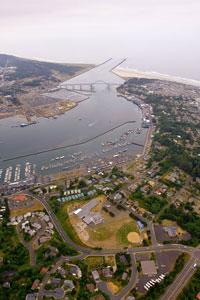EPA Science Matters Newsletter: Climate Ready Estuaries Program (Published August 2013)
EPA researchers assess coastal habitats to identify vulnerabilities and help communities prepare.

Estuaries are partially enclosed water bodies that serve as the connections between the ocean and freshwater rivers and streams. Both their water and surrounding soils are nutrient-rich, providing homes for some of the most biologically productive and diverse habitats in the world. These habitats are critical places for many species of fish to reproduce, for birds to find refuge and “refuel” during migration, and for people to swim and boat. Many also serve as sources of drinking water.
Estuaries are directly linked to environmental quality, human well-being, and national prosperity. Estuarine marshes help maintain water quality by filtering surface water runoff and retaining excess nutrients, pollutants and sediments. They decrease the impacts of coastal flooding by absorbing stormwater, preventing the inundation of surrounding communities. Estuarine habitats also serve as nurseries for commercially important fish and shellfish.
Estuaries are also highly vulnerable to the effects of climate change.
In the coming decades, estuaries will be threatened by rising sea levels, warming temperatures, and increasingly powerful storms. EPA researchers are working with the National Estuaries Programs (NEPs) and coastal managers to learn more about the risks estuaries face due to a changing climate, and are leading efforts to help coastal managers and others develop the capabilities (“adaptation strategies”) to protect them from the impacts of global climate change.
One vulnerable habitat that researchers have studied is the San Francisco Bay estuary, where EPA scientists collaborated with colleagues from the San Francisco Bay Estuary Partnership, and the San Francisco Bay Conservation and Development Commission to assess the ecological vulnerability of coastal systems in the Bay area.
“We looked at key processes that are critical to maintaining salt marsh and mudflat ecosystems,” explains EPA scientist Jordan West. “We asked: how are different physical and biological variables involved in processes such as sediment retention being impacted by climate change, and how do we separate all of these pieces and identify the greatest sensitivities? After we had done that, we could then look at what options might be available to communities for managing these problems.”
The project team convened a group of local experts to look at the different relationships between plants, animals, and physical processes in the San Francisco Bay estuary to determine which parts are currently the most sensitive and thus most likely to be impacted by climate change. Once they were able to identify sensitivities in the estuary, they developed adaptation strategies that the surrounding community could use to better manage risks and increase resiliency.
For example, salt marshes are sensitive to the effects that climate change will have on freshwater flows (the freshwater flowing into them from streams and rivers), as these flows affect salinity, which in turn, affects the growth of marsh plants. Thus one recommendation is to manage reservoirs for steady, low-volume releases during the growing season, to regulate salinity and favor marsh plant productivity. Since marshes are also sensitive to erosion during increasingly-intense storms, additional actions to consider are building berms or restoring oyster reefs as protective barriers against wave energy.
Because of the uncertainty surrounding the severity and timing of the effects of climate change, communities must develop strategies that account for a variety of potential circumstances.
“It’s essentially planning for many potential outcomes and being prepared to act on each one,” says West. “You have to look at a range of plausible scenarios. We use many different climate models that make different assumptions, which provides us with a variety of possible future scenarios. This lets us look for options that work across a range of outcomes. Alternatively, communities can prepare an assortment of options so that they have flexibility in their response based on what occurs in the future.”
The strategies developed by EPA researchers and their partners are providing decision makers in San Francisco and elsewhere with the information they need to develop adaptation strategies and make decisions based on sound science. Their findings, while site-specific, show that early planning could help vulnerable communities escape, or at least mitigate, some of the devastating impacts of climate change on estuaries around the country.
